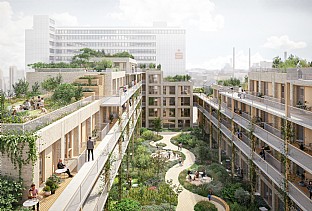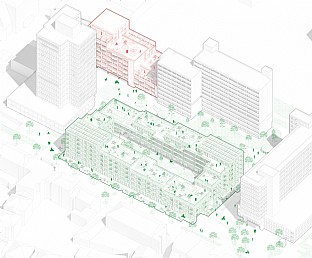By building upward rather than outward, the design preserves the existing structure while introducing a new, modular timber construction
By building upwards in modular timber that activates both rooftops and open spaces above the retained mall and parking structure, the design reduces material waste, preserves resources, and maintains the site’s use throughout construction —offering high-quality living with minimal environmental impact.
The new development will feature a mix of housing types – including subsidised units – alongside generous outdoor spaces for public, semi-private, and private use. Volumetric setbacks at key corners improve daylight access and create transitions to the surrounding context, while stepped terraces foster a layered urban profile. The result is an architecture that strengthens community and ecological integration through spatial generosity and a clear urban structure.
The new timber structure is set on overlay beams that gently distribute loads across the existing slab. Its minimal-invasive prefabricated construction ensures efficiency, minimizes disruptions, and supports a high level of design precision. The façade consists of warm-toned clinker elements and timber-framed windows, combining robustness with a welcoming, residential character. Floorplans follow a modular logic: most apartments are through-units or corner apartments, offering optimal light, ventilation, and flexible use.
Generously dimensioned and architecturally articulated gallery access routes serve both circulation and social interaction, gradually transitioning into semi-private zones and communal rooftop terraces. These green roofs are partially private, partially shared, and include biodiversity-friendly planting and photovoltaic systems. This layered approach not only enhances microclimate and energy performance but also expands the living space vertically.
A carefully zoned landscape concept connects the urban square to greener, quieter zones. Native vegetation, informal green spaces, and an integrated rainwater management system support biodiversity, climate resilience, and a high quality of life across generations and household types.






